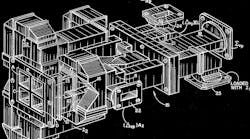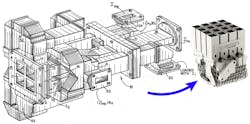Engineers at Optisys LLC, a company that makes complex antennas for high-performance aerospace and defense applications, recently completed a project that explored the advantages of using 3D printing to manufacture such devices. They also wanted to see if simulation and optimization could help them develop a smaller, lighter antenna that could be made quickly.
The test project involved a complete redesign of a high-bandwidth, directional tracking antenna array for aircraft (known as a Ka-band 4×4 monopulse array). Optisys handled every aspect of the design and printed the component in a single piece on a 3D printer from Concept Laser.
A large, multi-part antenna assembly (left) was redesigned into a palm-sized, lighter, one-piece, 3D-printed metal antenna (right).
The printer uses powder-bed fusion, which can make parts with the fine resolution needed for an antenna functioning in the 1 to 100 Gigahertz [GHz] range of RF, as most of Optisys’ customers do.
Making antennas via conventional methods such as brazing and plunge EDM are complex, multistage processes that take an average of eight months of development time and three to six more of build time, according to Optisys.
But designing with 3D printing in mind, engineers could take into account the entire antenna’s operation, combine many parts into one, and reduce both development and manufacturing times to just a few weeks. When the project was done, the resulting device was significantly smaller, lighter, and less expensive than previous attempts that lacked the benefits of 3D printing.
A profitability analysis done on the redesigned microwave antennae compared to a traditionally manufactured legacy design revealed some significant results. Optimizing the design for 3D printing let the company:
• Reduce part count reduction from 100 discrete pieces to a one- piece device.
• Cut weight by over 95%.
• Reduce lead time 11 to two months.
• Reduce production costs by 20%.
• Eliminate 75% of non-recurring costs.
Other advantages of 3D printing
Optisys can print in a variety of metals with its 3D printer, but for antenna products, aluminum is preferred because of its surface conductivity, light weight, corrosion resistance, and strength under shock and vibration. 3D-printed metal has virtually the same properties as a solid piece of the same material for RF performance, according to the company. They also have the same coefficient of thermal expansion (CTE) as wrought metals. This gives them better stability over a range of temperatures than plastic RF components.
Part consolidation through 3D printing provides a number of downstream benefits as well. For example, reducing part count also reduces assembly and rework. It’s also easier to add features to an existing 3D printed piece, easier to assemble the finished components, and, long-term, there is less testing, maintenance, and service when you have fewer parts, according to Optisys.


